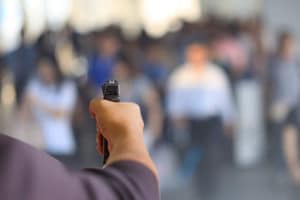The law was the first of its kind in the nation.

California is one of just 5 states in the country that allows police or family members to seek an order from a judge to direct an individual to turn in their firearms for a period of up to one year. This law, which was introduced in 2014 and went into effect in 2016. The way it works is relatively straightforward: an immediate family member or police officer can petition the court for a restraining order to prevent a person from having guns. If a judge determines that this person to be a risk, he or she can issue a gun violence restraining order (GVRO), which will:
- Temporarily prohibit that person from purchasing or possessing firearms or ammunition;
- Allow law enforcement to temporarily remove any firearms or ammunition in that person’s possession;
- Include procedures to allow the person have his or her guns and ammunition returned.
In 2016, 86 GVROs were issued.
Critics of this law argue that people are being punished before they commit a crime. According to a Los Angeles criminal defense attorney, Californians generally do not lose their gun rights unless they commit a particular crime, such as a crime of domestic violence. However, this process is an exception for public safety, inspired by the 2014 mass shooting on the University of California Santa Barbara campus. In that case, the shooter’s parents had repeatedly sought to have their son’s guns taken away, but police were unable to do so because there were no laws that allowed them to remove weapons from someone who was considered dangerous but who had not committed a crime.
Recently, Assemblyman Phil Ting sponsored a new bill that would expand the program by allowing employers, co-workers, high school and college staff, and mental health workers to also seek gun violence restraining orders. This would significantly broaden the scope of people who could claim that someone is dangerous — as well as increase the potential that someone could have their guns taken away unlawfully.
There is a delicate balance between protecting the public and protecting constitutional rights. If a person has not committed a crime, there is a question about whether he or she should have his right to own a gun taken away. This California law may be an effective tool to help reduce mass shootings, but it may also prevent people from exercising their legal rights.
California gun laws are complicated, including those involving gun violence restraining orders. If you have any questions about California’s gun laws, an experienced Los Angeles criminal defense attorney can help. Contact the Chambers Law Firm today at 714-760-4088 or dchambers@clfca.com to learn more or to schedule a free initial consultation.




